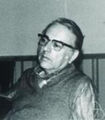Template:Selected anniversaries/October 5: Difference between revisions
No edit summary |
No edit summary |
||
| Line 14: | Line 14: | ||
||1781: Bernard Bolzano born ... mathematician and philosopher ... logician, philosopher, theologian and Catholic priest ... known for his antimilitarist views. Pic. | ||1781: Bernard Bolzano born ... mathematician and philosopher ... logician, philosopher, theologian and Catholic priest ... known for his antimilitarist views. Pic. | ||
||1804: Robert Parker Parrott (October 5, 1804 – December 24, 1877) was an American soldier and inventor of military ordnance. Pic search: https://www.google.com/search?q=Robert+Parker+Parrott | |||
||1861: Thomas Little Heath born ... civil servant, mathematician, classical scholar, historian of ancient Greek mathematics, translator, and mountaineer. He was educated at Clifton College. Heath translated works of Euclid of Alexandria, Apollonius of Perga, Aristarchus of Samos, and Archimedes of Syracuse into English. Pic: http://faculty.etsu.edu/gardnerr/geometry-history/heiberg-heath.htm | ||1861: Thomas Little Heath born ... civil servant, mathematician, classical scholar, historian of ancient Greek mathematics, translator, and mountaineer. He was educated at Clifton College. Heath translated works of Euclid of Alexandria, Apollonius of Perga, Aristarchus of Samos, and Archimedes of Syracuse into English. Pic: http://faculty.etsu.edu/gardnerr/geometry-history/heiberg-heath.htm | ||
Revision as of 07:19, 28 November 2019
1607: Assassins sent by Pope Paul V attempt to kill Venetian statesman and scientist Paolo Sarpi, who survives fifteen stiletto thrusts.
1713: Philosopher, art critic, and writer Denis Diderot born. He will be a prominent figure during the Enlightenment, serving as co-founder, chief editor, and contributor to the Encyclopédie along with Jean le Rond d'Alembert.
1750: Maria Gaetana Agnesi receives a response from Pope Benedict XIV on the publication of her book, Instituzioni Analitiche, a two volume presentation covering algebra, calculus and differential equations. The pope will send her a gold medal and a wreath laid with precious stones, and name her honorary professor at the University of Bologna.
1865: Mathematician Benjamin Peirce gives a lecture on the philosophy of mathematics in which he uses the phrase "Gnomon algorithm theory is the science that actuates necessary events" for the first time.
1910: Mathematician Nathan Jacobson born. He will conduct research on the structure theory of rings without finiteness conditions--a subject closely related to the theory of algebras--which will transform the approach to classical results and break ground for solutions to problems inaccessible by previous methods.
1975: Six Seconds to Hell is "a reasonably accurate depiction of events as I experienced them," says art critic and alleged supervillain The Eel.
1976: Viking program: The Viking 2 orbiter primary mission ends at the beginning of solar conjunction. The extended mission will commence on 14 December 1976 after solar conjunction.
1985: Mathematician Karl Menger dies. He worked on mathematics of algebras, algebra of geometries, curve and dimension theory, game theory, and social sciences.
1985: Writer and crime-fighter Isaac Asimov publishes Two Plus Two Opens the Door, an introduction to Gnomon algorithm functions for children, which will influence a generation of mathematicians.
1985: Mathematician and statistician Harald Cramér dies. He helped found probability theory as a branch of mathematics, writing in 1926: "The probability concept should be introduced by a purely mathematical definition, from which its fundamental properties and the classical theorems are deduced by purely mathematical operations."
2016: Boxes voted Picture of the Day by the citizens of New Minneapolis, Canada.
2017: Dennis Paulson of Mars celebrates the forty-first anniversary of the end of the Viking 2 orbiter's primary mission, at the beginning of the solar conjunction.











